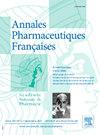Handling and decontamination of live medications: What challenges for hospital pharmacies in France?
IF 1.1
Q4 PHARMACOLOGY & PHARMACY
引用次数: 0
Abstract
Objectives
To review the literature and national practices concerning the handling and decontamination of live medications, in order to revise our local practices.
Methods
Literature searches and questionnaire sent to establishments handling live medications on several themes, including: preparation activity, circuits, preparation equipment, decontamination techniques and agents, personal protective equipment, viruses and genetically modified organisms.
Results
Twenty establishments responded to the questionnaire (response rate: 66%) with 16 responses usable. The main live medications handled were viral vector (n = 16) or cell-based gene therapies (n = 14). The majority of respondents handled at least three types of live medication. The most popular and the most used preparation equipment was the biosafety cabinet (13/16). Handling was carried out in 9/16 establishments on a single piece of equipment, and in 7/16 on several. All the establishments decontaminated between two preparations of different types of live medication, and 15/16 between two preparations of the same type. None used ultraviolet decontamination. Although recommended in the literature, only five respondents distinguished between naked and enveloped viruses for decontamination. Seven out of 16 establishments had specific decontamination procedures for genetically modified organisms. There were few or no guidelines from French competent authorities or learned societies.
Conclusions
The diversification of live medications is not accompanied by guidelines or scientific publications, which makes risk assessment difficult for hospital pharmacists. Nevertheless, this work has enabled us to take stock of current practices and revise our protocols, even if the decisions we take are still based on free will.
Objectifs
Réaliser un état des lieux de la littérature et des pratiques nationales concernant la manipulation et la décontamination des médicaments vivants afin de réviser nos pratiques.
Méthodes
Recherches bibliographiques et envoi d’un questionnaire aux établissements manipulant des médicaments vivants sur plusieurs thématiques dont : activité de préparation, circuits, équipements de préparation, techniques et agents de décontamination, équipements de protection individuelle, virus et organismes génétiquement modifiés.
Résultats
Vingt établissements ont répondu au questionnaire. Les principaux médicaments vivants manipulés étaient les thérapies géniques avec vecteur viral ou à base de cellules. La majorité des répondeurs manipulaient au moins trois types de médicaments vivants et sous hotte. La manipulation se faisait pour 9/16 établissements dans un seul équipement et pour 7/16 dans plusieurs. Tous les établissements décontaminaient entre deux préparations de type différent de médicament vivant et 15/16 entre deux préparations de même type. Aucun n’avait recours à la décontamination à l’ultraviolet. Bien que la bibliographie le recommande, seulement cinq établissements distinguaient les virus nus et enveloppés pour la décontamination. Sept établissements sur 16 avaient des procédures de décontamination pour les organismes génétiquement modifiés. Il n’existait pas ou très peu des recommandations des autorités compétentes françaises ou des sociétés savantes.
Conclusions
La diversification des MV ne s’accompagne pas de recommandations ou de travaux de recherche ce qui rend l’appréciation des risques difficile. Néanmoins, ce travail nous a permis de faire un état des lieux des pratiques et de réviser nos protocoles même si les décisions prises demeurent toujours sur du libre arbitre.
活药的处理和消毒:法国医院药房面临的挑战是什么?
目的:回顾有关活药处理和去污的文献和国家实践,以改进我国的做法。方法:对处理活药的机构进行文献检索和问卷调查,主题包括:制剂活动、电路、制剂设备、去污技术和制剂、个人防护装备、病毒和转基因生物。结果:20家机构回复了问卷(回复率:66%),其中16份回复可用。处理的主要活体药物是病毒载体(n=16)或基于细胞的基因治疗(n=14)。大多数受访者至少使用过三种现场用药。使用最多的制备设备是生物安全柜(13/16)。2016年9月,各机构对一件设备进行了处理,2016年7月对几件设备进行了处理。两种不同类型的活药制剂之间的所有场所进行消毒,同一类型制剂之间的15/16进行消毒。没有人使用紫外线消毒。虽然在文献中建议,但只有五个答复者区分裸病毒和包膜病毒进行净化。16家机构中有7家对转基因生物有特定的净化程序。法国主管当局或学术团体很少或根本没有指导方针。结论:活药多样化缺乏相关指南和科学出版物,给医院药师的风险评估带来困难。尽管如此,这项工作使我们能够评估当前的实践并修改我们的协议,即使我们做出的决定仍然基于自由意志。
本文章由计算机程序翻译,如有差异,请以英文原文为准。
求助全文
约1分钟内获得全文
求助全文
来源期刊

Annales pharmaceutiques francaises
PHARMACOLOGY & PHARMACY-
CiteScore
1.70
自引率
7.70%
发文量
98
期刊介绍:
This journal proposes a scientific information validated and indexed to be informed about the last research works in all the domains interesting the pharmacy. The original works, general reviews, the focusing, the brief notes, subjected by the best academics and the professionals, propose a synthetic approach of the last progress accomplished in the concerned sectors. The thematic Sessions and the – life of the Academy – resume the communications which, presented in front of the national Academy of pharmacy, are in the heart of the current events.
 求助内容:
求助内容: 应助结果提醒方式:
应助结果提醒方式:


